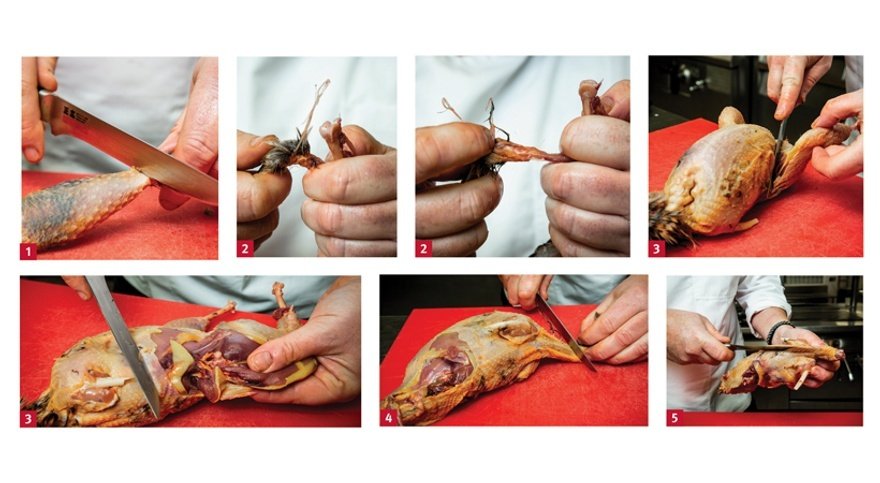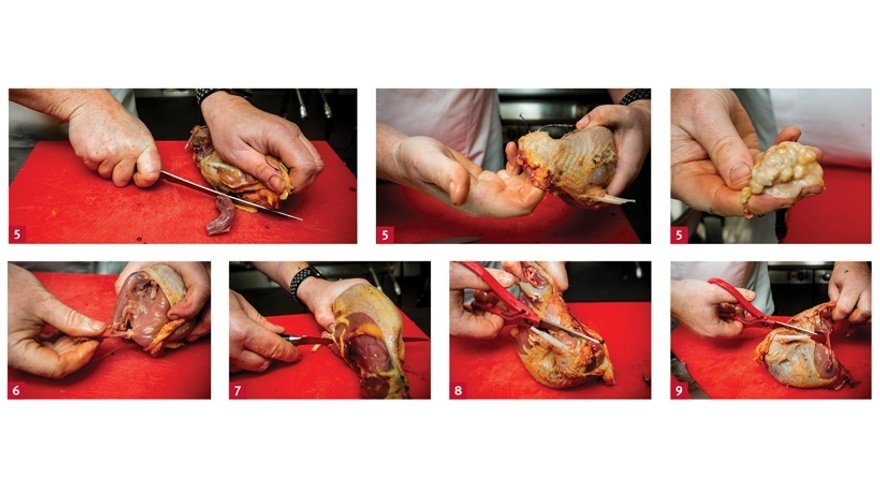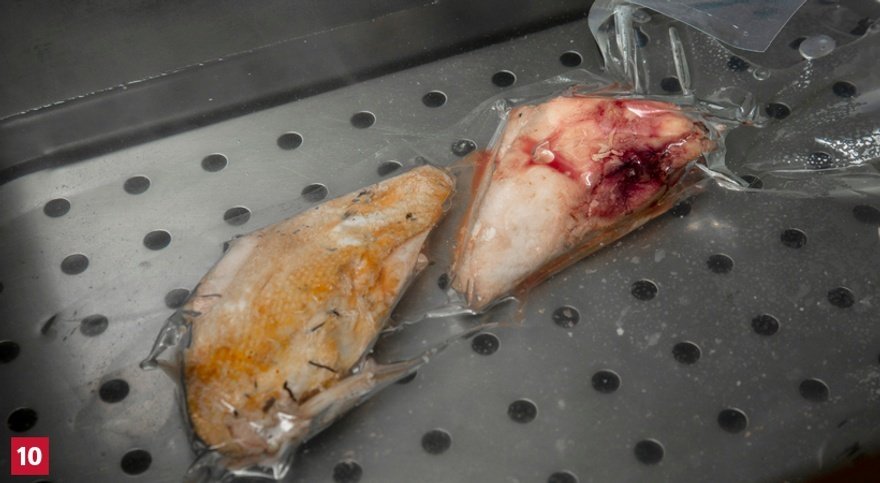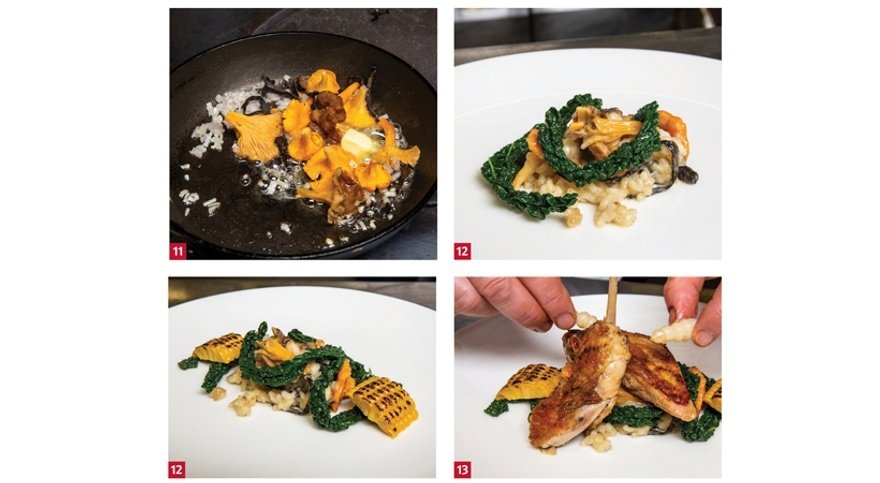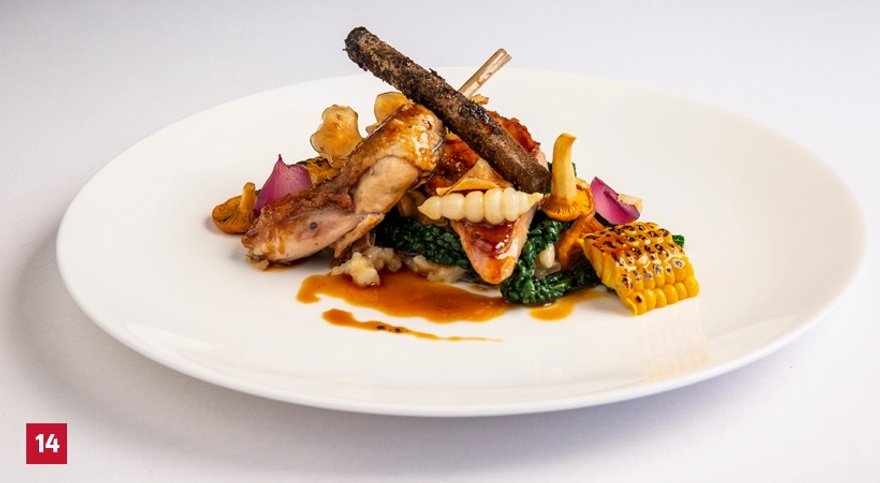‘Tis the season to eat pheasant, and head chef Aaron Patterson at Hambleton Hall has three ways of cooking the bird: with a risotto, as a pithivier and as a terrine. Michael Raffael reports
The pheasant season lasts over Christmas until February. The pheasant, hatched and reared on game farms (about 200 in the UK), feed the appetites of hunters as flying targets and, in that respect, they've outgrown their ‘wild' status – but not their value as food.
To buy they are as cheap as proverbial chips – in fact, gamekeepers often waste carcasses, burying those that they can't sell. To eat they have as much to offer as mallard, pigeon or partridge, and it isn't so long ago that they figured on three-star menus.
At Hambleton Hall in Oakham, Rutland, Aaron Patterson receives between 30 and 50 birds a week. After hanging the birds for six to eight days, he roasts the best, undamaged birds, makes terrines or pies from the rest and a game jus from the bones. Patterson, head chef at the hotel since 1992, has unparalleled experience in selecting and handling feathered game. The hotel uses its own plucking machine to remove feathers from the carcasses, and the sheared wings are discarded. Pheasants reach the kitchen undrawn, with their feet intact and the heads retaining their ruff of feathers.
Planning
- Triage and pheasant preparation at the start of the week
- Make the pheasant jus
- Water-bath the legs
- Water-bath the breasts
- Make the risotto base pre-service
- Make the vegetable accompaniments
- ‘Pan-roast' to order
- Assemble
Cost
Hambleton Hall has a £31 lunch menu, two dinner menus at £78 for three and £92 for four courses, and a £95 tasting menu. The pheasants may cost anything from zero to a couple of pounds per brace. This gives Patterson the freedom to be as extravagant as he wishes with accompaniments.
Quality control
A prime concern with pheasants is shot damage and it's the first step in the triage that determines how the kitchen uses the bird. Hens are smaller. Age is less significant than it once was, but hard beaks and developed spurs indicate older birds. As with poultry yellow fat on the breast signals that pheasants have ingested plenty of corn.
For roasting, choose undamaged breasts and legs, matching them up during preparation. For terrines, use undamaged breasts. For pies, make a farce from other breast and leg meat, adding livers and hearts. Carcasses, bones and other damaged meat go towards the jus.
Preparation
Pull out the tendons from the legs: cut through the skin just above the joint between drumstick and foot (1). Snap the joint and pull the foot away with the tendons (2). Cut off the two legs, just as you would with a chicken (3). Cut off the head below the feather line (4). Lay the pheasant on its breast. Slit the skin down the middle of the neck. Cut off the neck. Pull out the crop (5).
Turn the pheasant on its back and remove the wishbone, just as you would with a chicken (6). Cut through the skin on either side of the carcass towards the parson's nose (7). Extract the innards.Separate the carcass from the keel bone and breasts (8). Split the breasts, leaving the keelbone attached to each half (9).
Pre-cooking the legs and breasts
The Hambleton Hall kitchen uses large waterbath bags to cook 8-10 portions, but for the purpose of the photographs, Patterson used two pieces per small pouch.
The waterbathing process has two advantages: it ensures the leg meat is tender and guarantees the breast won't dry out. Pack the legs with sprigs of thyme, rosemary and garlic to taste. Seal the bags without pressure. Waterbath the legs for six hours at 75°C. Chill.
Pack the breasts and seal without pressure. Waterbath for 20 minutes at 65°C. Chill and remove the bones – retain them for the jus (10).
Roast pheasant and wild mushroom risotto
Serves 1
- 20ml sunflower oil
- 60g butter
- 1 clove garlic
- 1 pheasant breast (part-cooked)
- 1 pheasant leg
- Salt
- 30g finely diced shallots
- 30g sliced wild mushrooms (chanterelles, ceps, etc)
- 60g freshly cooked risotto
- Vegetable accompaniments (see panel)
- 50ml pheasant jus
Heat the oil and 20g butter in a frying pan. When it foams add both the breast and leg. Pan-roast till they are well-coloured on all sides and season with salt.
Add a knob of butter to the preheated risotto. Fry the shallots and mushrooms in the rest of the butter without colouring them (11). Season. Fold into the risotto.
Arrange the risotto in the centre of the plate and arrange the vegetables on top (12). Place the breast and leg on top of that (13), and finish with pheasant jus (14).
Vegetable accompaniments
Change according to season and availability:
- 5-6 scrubbed crosnes, blanched for less than a minute in butter/water emulsion
- 2-3 cavolo nero leaves blanched for 30 seconds and in a butter/water emulsion
- 1 stick cooked salsify tossed in trompette des morts powder
- 2 squares blowtorched corn on the cob
- 2-3 wild mushrooms
- Jerusalem artichoke crisps
- Pickled pearl onion leaves
- 1 slice of truffle
Pheasant pithiviers
Game pithiviers were a fashion in the 1980s when French provincial chefs like Paul Bocuse, Jean and Pierre Troisgros and Michel Guérard led the charge. They took an 18th-century recipe for a puff pastry game pie, tweaked the filling, added foie gras and served it with a truffle sauce.
Patterson makes his farce filling with two pheasant hearts, two livers and two pheasant breasts. He blends them with four eggs, 200ml olive oil, Armagnac, spices and seasoning.
The filling goes inside round individual puff pastry packages scored with the characteristic pithiviers marking and baked for 25 minutes at 180°C.
Pheasant terrine
Line a terrine with Serrano ham. Pack it with alternate layers of seasoned water-bathed pheasant breast and sautéed field mushrooms. Intersperse with pistachios and flatleaf parsley. Pour over a jellied Madeira stock to fill the terrine. Fold over the flaps of ham and leave in the refrigerator to set.
Pheasant jus
For approximately 250ml jus, sweat 50g diced banana shallots, 50g sliced mushrooms and 30g diced smoked bacon, 1 garlic clove and a sprig of thyme in a little oil. When the shallots are transparent add a knob of butter, 100ml dry white wine and 100ml Madeira. Boil for three minutes.
Add 150ml concentrated brown veal stock and 150ml white chicken stock. Boil, skim and reduce to a glaze. Pass twice through muslin.
Hambleton Hall scales up this recipe by 10.
Aaron Patterson
Young Aaron Patterson travelled with his parents, clocking up 13 different schools before turning 16. His father was a trouble-shooter chef for the now-extinct Grand Metropolitan hotel group, and work meant criss-crossing the country.
Patterson's nomadic childhood gives a clue to why he has stayed in situ at Hambleton Hall since 1992, since when he has retained the Michelin star first awarded to the hotel 10 years earlier. Further recognition has come with four AA rosettes and a 7/10 rating in The Good Food Guide. This consistency and loyalty over 27 years earned Patterson the Extra Mile Award at this year's Hotel Cateys.
This is his second spell at the Rutland Water hotel. Patterson had already completed a three-year apprenticeship there before moving to Raymond Blanc's Belmond Le Manoir aux Quat'Saisons. Then, Hambleton Hall, which represented the cutting edge of British nouvelle cuisine. Its head chef, Nick Gill (the late food critic AA Gill's younger brother) was among the first British chefs to earn a Michelin star. Gill left the hotel and became an early casualty of celebrity chef culture. His London restaurant failed, he did time for attacking his ex-wife, he went missing and has not been seen since 1998.
It was no accident that Patterson returned to Hambleton Hall. He'd stayed in contact with owner Tim Hart and made it clear that he wanted to put down roots.
"I dogged him till he needed a new chef," he says. "Taking me on was a real gamble for him because I was only 23. Even then, I knew this was the place for me; it's my home."
Patterson's father taught him the basics of classical cookery. "My father was a volatile, old-school, grumpy chef, but he was very passionate. He adored food. If he wasn't cooking, he'd be reading cookery books. If he wasn't doing that, he was eating. As a child I remember there was always a Michel Guérard book on the coffee table." Trim the "volatile, old-school, grumpy" part, and that describes the son.
Patterson has lived through culinary fads without losing his belief that good ingredients matter more than fashion: "Use the best ingredients, don't mess about with them too much and you can't go wrong."
He wouldn't bother with foams or crackled crystal desserts, he says, but he had no problem with the techniques and gadgetry that have changed the kitchen.
Chefs are notorious for saying that they cook simple cuisine and their dishes turn out to be complex, multilayered creations. Patterson admits to a gut feeling about the current trend, where recipes are less tricksy and more focused around the main ingredient.
"I went to every two-star in the country and some abroad and there's been a shift. Ten years ago I'd have taken a tomato and done it in seven or eight ways. What I'm doing now is related to what I was doing as a young chef. I'm not trying to show off. If you cook for someone interested in food, what matters is flavour and texture – and that's what we do."
Continue reading
You need to be a premium member to view this. Subscribe from just 99p per week.
Already subscribed? Log In


